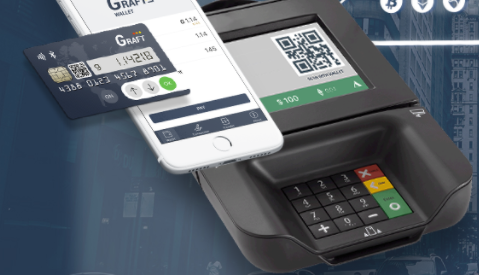GRAFT: CHANGING THE WORLD OF CRYPTOCURRENCIES AND PAYMENT PROCESSING.
GRAFT: CHANGING THE WORLD OF CRYPTOCURRENCIES AND PAYMENT PROCESSING.
Graft is a global, open-sourced, blockchain-based, decentralized payment gateway and processing platform that anyone can use. Any buyer and merchant can use Graft in a completely decentralized and inexpensive way. Graft ecosystem is open so anyone can participate by maintaining Graft blockchain and implementing network services.
Graft employs payment processing protocols and flows similar to traditional electronic payment systems such as credit, debit, and prepaid cards, which are already familiar to and trusted by millions of users and merchants around the world. This approach enables easier and faster adoption of Graft as a mainstream payment platform, while eliminating the need in centralized intermediaries (payment gateways and processors) currently required to facilitate transactions between buyers and merchants.
Bitcoin was created as an “online cash” - very secure but relatively slow settlement system which was unable to replace payment cards online or compete with both plastic cards and paper cash in brick-and-mortar stores.
Even though some existing cryptocurrencies have improved confirmation times, they are still unable to process essential transactions types such as authorization and completion, which makes their adoption by retail, hospitality, and convenience store industries impossible without using intermediaries - payment processors and gateways- who fill the gap. However, the very existence of payment processor, which is typically a centralized commercial organization regulated by government and controlled by shareholders, as an element of crypto payment transaction contradicts the fundamental principles of cryptocurrencies: decentralization, privacy, and independence.

Most merchants are unable to accept cryptocurrencies without third-party payment processor due to uniqueness of the way blockchain networks process transactions, which is conceptually different from traditional electronic payment methods such as payment cards or Paypal. Although the overall concept of plastic card payments may have been outdated, there are technologies developed around them that accumulated enormous amount of merchant experience and user trust which cannot be abandoned overnight. Those technologies include real-time authorization protocols and smart cards. There are several major differences between the ways traditional and cryptocurrency payment systems handle transactions, which in most cases make cryptocurrencies less attractive for merchants and/or consumers. Here is the list of technical limitations and business flaws of the existing cryptocurrencies comparing to traditional electronic payments:
•Lack of Essential Transaction Types
•Unsuitable Payment Flows
•Long Confirmation Times
•Unbalanced and Unpredictable Transaction Fees
•Inability to Process Micropayments and Repeating •Charges (Subscriptions)
•Lack of Offline Transactions support
•Low Scalability
•Volatility
Incomplete Security
•Lack of Privacy Due to Traceability of Blockchain
•Lack of Trust between Buyer and Merchant
•Questionable Utility
•Poor Usability of End-User Interfaces
•Lack of Customer Support

By addressing all those issues, Graft elevates crypto payment processing to a new level, and makes possible their wide acceptance by mainstream merchants and consumers for the first time without violating the fundamental principles of cryptocurrencies. Let’s review each of those issues with greater detail and see how Graft addresses them.
Graft Transaction Fees
Graft reintroduces convenient fee structure with no fees for the payer so all fees are paid by the receiver (merchant), just like everyone used to do with traditional electronic methods of payment. Graft makes micropayments accessible to everyone by setting very low (comparing to credit cards and online payment processors, and other cryptocurrencies fees, but without fixed fee component. All fees are paid by the payees.
The second problem with DOS threat is resolved by voluntary user identification and authentication. Of course, there are no free lunches, so the users should "pay" by providing their identity to the network to ensure the reasonable use (by limiting the number and frequency of free transfers per user) and prevent the network abuse. However, using zero knowledge proof authentication technology will allow users to prove their identity without compromising their privacy.

Cryptocurrency networks usually cannot "afford" free transactions for three major reasons:
•Lack of incentive for miners
•Threat of DOS attacks
•Uncontrolled growth of blockchain
The last problem with uncontrolled block size growth is resolved by a complex of measures: small block interval, unlimited block size, and standard restricted transaction size for particular transaction types such as free transfer. In addition, one of the sides of the free transfer must prove that they contributed to the network by conducting “commercial” payment transaction types in the past.

Graft wouldn’t exist without its predecessors. It is based on ideas, principles, and technologies introduced and tested by creators of other cryptocurrencies. Using most recent technologies developed by crypto community along with newly developed solutions for transaction processing and security will allow Graft to compete with traditional payment methods and existing centralized payment processors.
Graft will implement best-practices, advanced authentication to go along with the user management service, which will include risk / threat analytics based on login/usage pattern as well as device and network characteristics, sophisticated multi-factor based authentication which will include biometrics, FIDO and other passwordless factors and techniques to identify the user.
The ultimate goal is to make user identification and authentication work quickly, reliably, in wide variety of situations, on wide variety of devices; while providing user with choices and that are reflective of user preferences and limitations.
graft2017

This post has been submitted for the OriginalWorks Sponsored contest!
You can also follow @contestbot to be notified of future contests!
@OriginalWorks
The @OriginalWorks bot has determined this post by @oakinlade to be original material and upvoted it!
To call @OriginalWorks, simply reply to any post with @originalworks or !originalworks in your message!